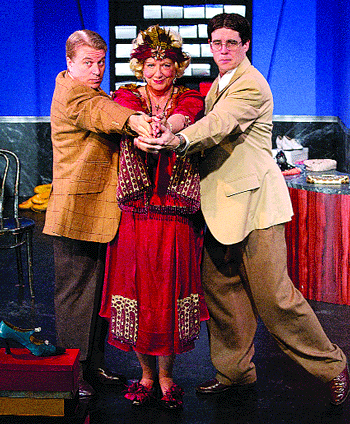A musical pays tribute to a forgotten Manhattan landmark store
My favorite Manhattan building, at 46th Street and Seventh Avenue, appears like a typical commercial structure with its undistinguished street-level store front. But let your eyes wander skyward and you will see four Alexander S. Calder statues from1928-29 representing the performing arts. There stands Ethel Barrymore as Ophelia (drama), Marilyn Miller as Sunny (musical comedy), Rosa Ponselle as Norma (opera) and Mary Pickford as Little Lord Fauntleroy (film), whose likenesses were commissioned for the 1926 remodeling of the Times Square branch of the stylish I. Miller women’s shoe store chain. Under the building’s cornice an inscription reads: “The show folks shoe shop dedicated to beauty in footwear.”
“Shoe Palace Murray,” written by William Hoffman (“As Is”) and Anthony Holland, is a musical imagining of what went on in the store on August 26, 1926, the day of Rudolf Valentino’s legendary funeral at Frank E. Campbell’s funeral chapel. Two salesmen, Murray (Chip Phillips) and Benny (Jim Ireland), become embroiled with the mistress of a mobster (Sarah Ireland), the mobster himself, and Murray’s innocent fiancée (Christa Capone). Celebrities Texas Guinan (Judith Barcroft) and Alla Nazimova (Delphi Harrington) also pop in to shop and dish the Rialto dirt.
It’s a modestly appealing little work that never quite approaches the delicious heights of that greatest of musicals set in a shop, “She Loves Me.” Although the playwrights capture the authentic flavor of the period in language and detail (references to dancers Ann Pennington and Gilda Gray; Benny’s lunch consists of chicken croquettes, lima beans and lemon chiffon pie), the characters are mostly two-dimensional cartoons and the songs (by Jeff Layton) particularly undistinguished and inorganically tacked on. On the plus side are Emmett McConnell’s charming set design (on Circle East’s modest Baruch College stage) and Meredith Moseley’s richly detailed Roaring ‘20s costumes.
Barcroft, in a small role, is the cast standout, skillfully bringing Texas Guinan to raucous life, without once relying on that personality’s signature greeting, “Hello, suckers!” (Waco-born Guinan was the Nell or Amy Sacco of her day, sometime actress and queen of a fleet of nightclubs that personified Prohibition-era excess. Her wild life ended in 1933, at age 49, and she once joked, “The funeral I want is a nightclub wake, a motorcycle escort, and college boys singing songs to the cemetery.” Twelve thousand people turned out to view her body at Campbell’s.
Ireland gets laughs with his Jerry Lewis schtick as the nerdy, asthmatic Benny. Phillips is adequate but lacks the electrifying charisma that would make you root for his shallow charmer of a character. Ireland is a shrieking caricature in the kind of role forever immortalized by Lesley Anne Warren in “Victor, Victoria,” but she does get the best line in the play when Murray calls her a “crazy, vicious cunt”: “Who’re you calling crazy?” Capone has a dewy sweetness but is rather inaudible in her solo song. Harrington, something of an Off Off Broadway regular in period productions, is not as grating as usual, but rather turns the great Nazimova into a simplistic Russky stereotype. (Nazimova, one of the 20th century’s most incandescent actresses, was lauded by Tennessee Williams and Pauline Kael, who acclaimed her performance in “Ghosts” as the greatest they’d ever seen.)
On her deathbed, Texas Guinan said, “I would rather have a square inch of New York than all the rest of the world,” and, for the undemanding, this show brings a little-known corner of town back to life.
gaycitynews.com



































